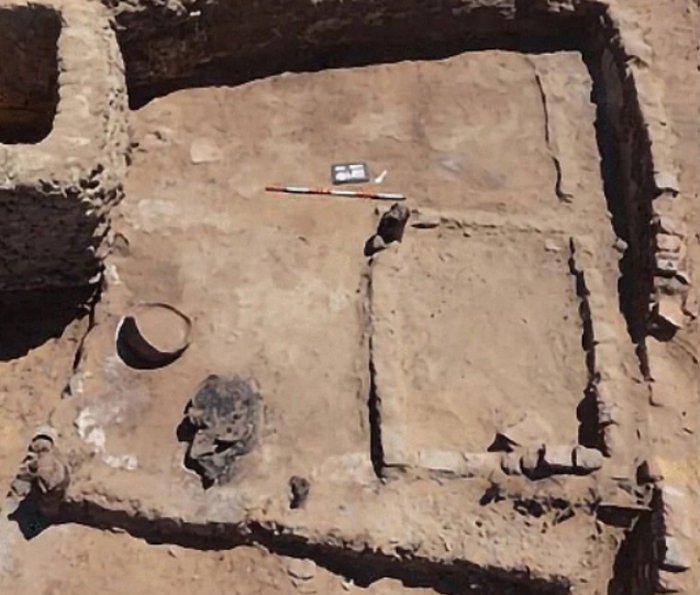Conny Waters – AncientPages.com – Makuria was a medieval Nubian kingdom located in what is today northern Sudan and southern Egypt, spanning from the 4th century to 1518.

Vessel FN916. Image credit: L. de Lellis – source
It was one of the Nubian kingdoms that emerged in the centuries following the fall of
the Kushite Kingdom, which had dominated the area from approximately 800 BC to 350 AD.
From the 5th to the 14th century, Old Dongola was the capital of the Kingdom of Makuria, one of the most important states of the African Middle Ages. It had its location – from the Third cataract, to
somewhere between the Fifth and Sixth cataracts – at the end of Wadi Howar, in the historical region called Nubia, in present-day Egypt and Sudan.
Wadi Howar was an important sub-Saharan communication route , and this area largely contributed to the region’s development.
As Old Dongola was situated along the Nile River in present-day Sudan, it was under the influence of African and Middle Eastern cultures for centuries, which included, among others, food.

Location of Old Dongola and the medieval Nubian Kingdoms, including major archaeological sites along the Sudanese Nile Valley. Image credit: Adrian Chlebowski – source
A new study was conducted by the Polish Centre of Mediterranean Archaeology of the University of Warsaw in cooperation with the University of Tübingen. The results of the study, led by Mohammed Nasreldein, PhD, from Eberhard Karls University in Tübingen, were published in the journal African Archaeological Review
Researchers have identified significant quantities of sorghum, wheat, and barley grains, suggesting that they were the basic source of carbohydrates for the inhabitants of Old Dongola and the basic ingredients of the local diet during the rule of the Funj Dynasty spanning from the 14th-18th centuries AD.
The samples used in the analysis were collected during excavations conducted in the winter of 2021–2022. Researchers successfully identified a total of more than 29,000 seeds.

Quern emplacement (F1417) and several grinding stones (FN912) inside U235. Image credit: L. de Lellis – source
The study shows cowpea (Vigna unguiculata) is the most abundant plant, comprising 29% of identified seeds. Other common plants include common barley (28%), sorghum (17%), common wheat and wild radish (both 10%), and field pea (6%).
‘These plants are referred to as the savannah package, resistant to drought, which started to affect Sudan already in the early Holocene. Their migration north, towards Egypt, took place mainly along the Nile’, explains one of the authors of the publication and head of the excavations in Old Dongola, Professor Artur Obłuski from the Polish Centre of Mediterranean Archaeology of the University of Warsaw.
Based on data on current grain consumption in Sudan, the researchers estimated that approximately 149 kg of grain per person per year was consumed in Old Dongola during the Funj period. The majority were sorghum (106 kg), millet (28.6 kg) and wheat (14.4 kg).

The citadel in Old Dongola with marked locations of the houses discussed in the paper (credit: Adrian Chlebowski). Source: African Archaeological Review
Meat, especially beef, lamb, goat and camel meat, as well as wild game (gazelle and antelope) and Nile fish, were important components of the Funj diet in Old Dongola. However, as we read in the publication, the inclusion of the above-mentioned plants probably shifted the proportions of consumed macronutrients towards a higher share of carbohydrates.
‘Although precise estimation of caloric values is difficult due to limited data, the presence of sorghum, wheat and barley in significant quantities suggests that these cereals were probably the primary source of carbohydrates during the Funj period’, Obłuski explained.
For instance, Kisra is a type of flatbread traditionally made from sorghum and baked on ceramic plates. Another common dish is asida, which has a doughy texture similar to tofu. In line with contemporary Sudanese cuisine, wheat and barley are often used to make gurassa, a thick pancake-like dish. Additionally, madida is prepared using flour combined with fenugreek to create a porridge-like consistency.

View of one of the houses with visible burnt seeds. Image credit: A. Deptuła. Source: African Archaeological Review
The architectural design of houses from the Funj period in Old Dongola reveals that each household was equipped with its food storage facilities. This suggests a level of self-sufficiency and organization within individual homes during that era.
Most often, houses had pantries located behind the living room, differing in size and capacity. This was often the most hidden place, for storing the most valuable things. The storage vessels were supposed to be sufficient to meet the needs of 5 to 17 adults, i.e. quite a large family.
The storage rooms where grains were discovered offer researchers significant insights into the strategies employed for managing agricultural resources and food storage within households in Old Dongola. For example, one of these rooms, which served as a pantry within the living quarters, was destroyed by fire in the mid-16th century.

View of one of the houses with visible burnt seeds. Image credit: A. Deptuła. Source: African Archaeological Review
This event resulted in the collapse of its roof and walls; however, it also preserved large number of burnt grains and legumes. The presence of large storage containers further suggests that crops were intentionally stored in this room.
Further storage facilities were found in the open space of one of the home courtyards. There were also tools used for food processing, including millstones. Their presence indicates a complex system of food storage and processing. The finding of only partially cleaned sorghum grains there raises questions about their purpose – for consumption, long-term storage or perhaps as seed material.
‘Storing unpeeled grains could have been a deliberate strategy to extend the shelf life or preserve the ability to germinate, or to use them as feed’, Obłuski commented.
Source
Written by Conny Waters – AncientPages.com Staff Writer









